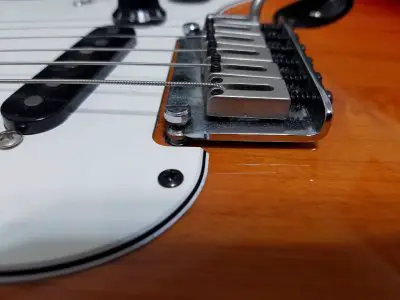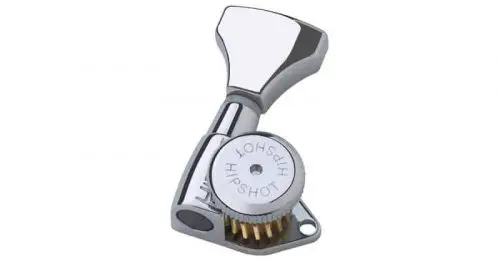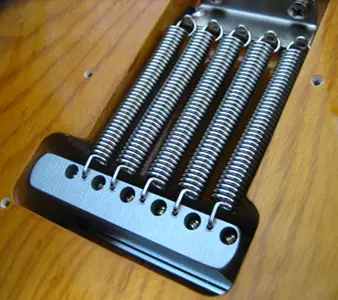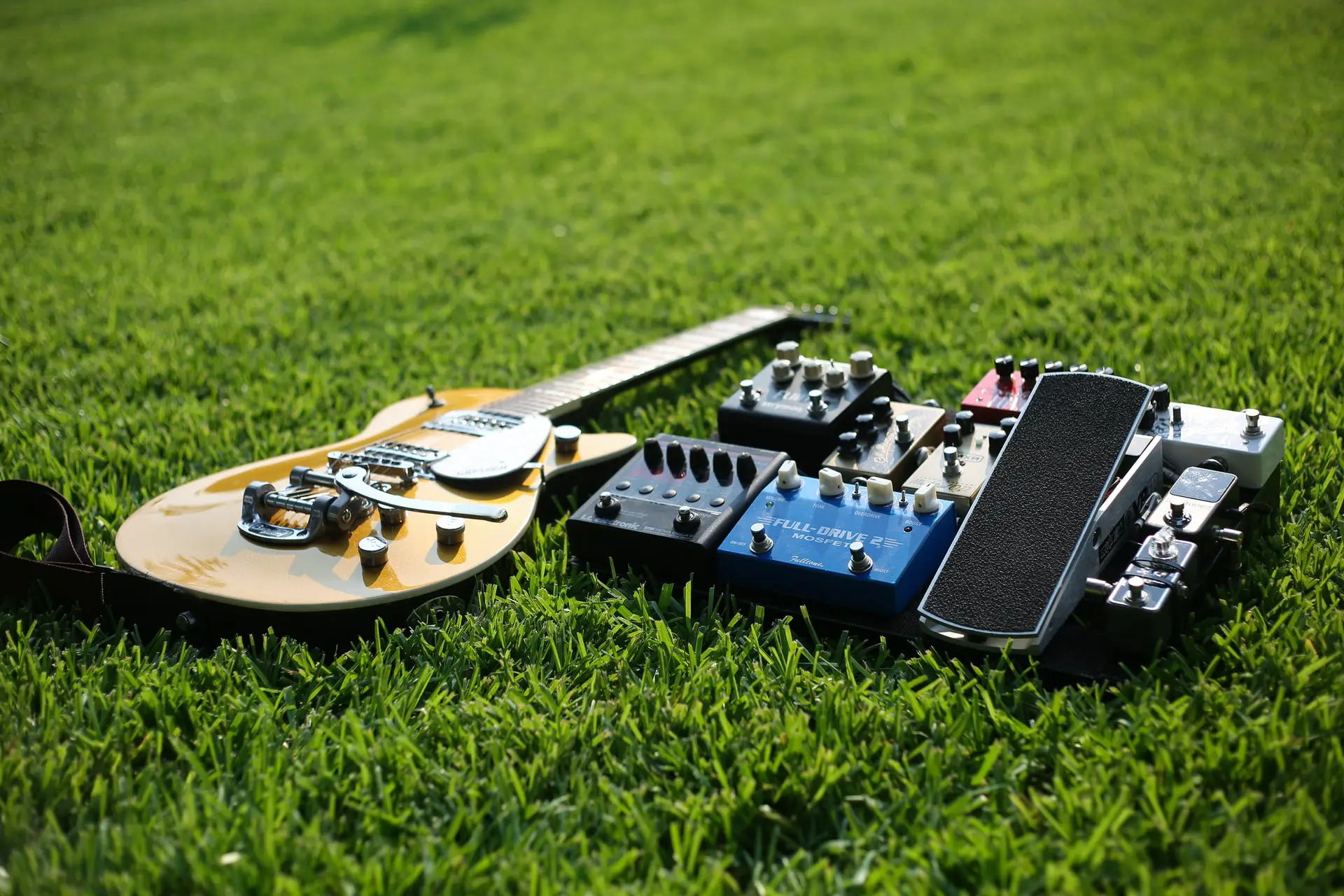Regularly using whammy bars (tremolo) will definitely put your guitar out of tune – whether it be a floating or non floating system.
Detuning happens because the guitar strings slowly unwrap from the tuning post and malposition in the nut slot as you pull and push them while using the whammy bar.
If you are a little confused, a whammy bar changes the pitch of your guitar by tightening up or loosening the tension in the string as you use them.
A whammy bar is connected to the guitar bridge and as you apply pressure to it, the bridge of your guitar tips over – loosening your guitar strings (or tightening for a floating system). Thus, the change in pitch.

Whammy bar changes tone by pulling the bridge up (or down) to change tension and sound.
I have never seen any guitarist that doesn’t have detuning issues when constantly using the whammy bar (unless the guitarist has a super expensive tremolo set or locking nuts in place – majority doesn’t).
Personally, my guitars go out of tune pretty quickly when I keep using the whammy bars. As the years go by, I have learned some tips and tricks on reducing that detuning.
In this article, I will cover 7 tips to prevent detuning when using the whammy bars and also discuss related topics like damages from whammy bars or how tight should whammy bars be.
You should know much more things about the whammy bars after this and definitely won’t have as many detuning issues anymore.
By the way, In this article I am going to mention the term ‘Tremolo System’ and ‘Whammy Bar’ interchangeably. The entire whammy bar system is called the tremolo system. Whereas the whammy bar itself is also known as tremolo bar.
Whammy bar and tremolo are interchangeable – so don’t get confused!
7 Ways To Prevent Detuning When Using Whammy Bars
1. Use locking nut
Locking nut is a nut which ‘locks’ or clamps down the strings in place when you play or bend it with whammy bars.
This means, with a locking nut – your strings stay in place (and in tune) no matter the movement you make on them with a whammy bar.
A locking nut is the most common way to keep your guitar in tune when using whammy bars. Most guitars that come with a tremolo set pre-installed, usually come with a locking nut as well.
If your guitar doesn’t have a locking nut, then it’s no wonder why your guitar goes out of tune regularly with the whammy bar.
Installing a locking nut is not easy though. You need to remove the existing nut from your guitar and scrape off all the glue – before installing a new locking nut.
You also need to unwrap all your strings from the tuning post and insert them into the locking nut. Here’s a YouTube video showing you how to install a locking nut.
It’s not easy to install, but a locking nut will definitely prevent your guitar from going out of tune when playing with a whammy bar. It’s a night and day experience for me. (although, I did not install it myself – rather the guitar shop)
2. Use locking tuner
Locking tuners are guitar tuning posts that have a built-in clamp – which clamps the strings down in place when you tighten the tuning post.
Locking tuner works similarly to a locking nut and should help a lot in keeping your strings in tune (especially if you regularly use a whammy bar).
Locking tuner is easier to install than a locking nut. You just have to remove the strings from your existing tuning post and replace them with your new locking tuners. You don’t have to use force or scrape anything.
If you are a beginner or simply don’t want to permanently change your guitar, then a locking tuner is the best approach.
Locking tuners are not that expensive (also not cheap). Here’s one from Amazon for about $50.

Tuning locker has a clamp that keeps your string locked in place – keeping it tuned.
3. Avoid excessive usage
To prevent detuning your guitar, simply avoid using your whammy bars for too long or too hard. Occasionally using the whammy bar is fine – especially if you use it to loosen the string and lower down the pitch.
This sounds like a no-brainer but it’s quite effective. Don’t be aggressive on the whammy bar and you should not go out of tune that quickly.
Do not press down too hard on the tremolo – you have to be precise about it. Apply only the necessary pressure to get the sound you need and not more.
I will talk about how far you can bend the whammy bar later .
4. Stretch new strings to break them in
Brand new guitar strings need to be stretched and tuned at least 3 times to break-in, otherwise detuning can happen.
If your guitar strings are new and they detune, it might not be the fault of your whammy bar. Make sure you try stretching your strings gently and try tuning them around for at least 3 times before they are ready for use.
If you don’t try to break them in intentionally, then the guitar strings will probably break in after a few hours or so.
Guitar strings need a short phase to “break-in” because when guitar strings are installed on a guitar, they are used in incredibly high tension. It takes some time for the material to adjust.
5. Install more springs on the tremolo system
You can install more spring on the tremolo system to make it harder to bend and thus, increasing precision.
This way, your guitar will likely stay in tune; you will only apply as much pressure to the whammy bar as required to produce the sound – and not accidentally go overboard and detune your guitar.
The springs for the tremolo system are located behind the guitar (you need to flip the guitar). A typical tremolo system has 5 available locations for the spring – add more springs and the whammy bar will feel harder.

Tremolo system spring.
6. Use tuning lubricant
You can use tuning lubricant like Big Bends Nut Sauce on the contact points between the string and the nut; and also the bridge to ensure guitar strings can easily slide back into position and prevent detuning.
When using a whammy bar, some strings can go out of tune because they slip out of the nut or bridge saddle.
Apply the tuning lubricant to ensure your strings stay in tune while using the whammy bar. Note: Tuning lubricant also works well in keeping your guitar in tune even if you don’t use a whammy bar.

Tuning lubricant helps keep your guitar in tune for longer.
7. Opt for non-floating tremolo
A floating tremolo system can put your guitar out of tune much easier than a non-floating block style tremolo. Which is why using a non-floating tremolo is great if you want to stay in tune longer.
Floating tremolo systems need to balance the tension between the strings to make sure it’s sitting straight (on a level).
Floating tremolo can easily go out of tune if the tremolo system is not on level – easily done when you are jamming.
Typically, if you are using a floating tremolo and you don’t have a locking nut – you can expect to go out of tune after every song. Kinda annoying eh?
Fortunately, most guitars that come with a floating tremolo system should have a locking nut pre-installed that decreases the detuning.
Will Whammy Bars Damage Guitar Strings?
A whammy bar will not damage the guitar, nor the guitar strings. The only problem is they can go out of tune quite often (depending on your playing).
I personally have not seen anyone who broke their guitars because they aggressively use the whammy bars (nor have I ever).
Using a whammy bar should be safe. Especially if it comes pre-installed with your guitar purchase. Just make sure you follow my tips above to keep the strings in tune.
If you install a whammy bar by yourself, then you have to make sure it’s installed properly. The worst case scenario would be your whammy bar is not screwed tightly and you damage the guitar bridge as you press too hard.
How Far Can You Bend Whammy Bars?
Bending a whammy bar too far will not damage the guitar strings – it will just make your guitar go out of tune quicker.
Whammy bars can usually bend as far as your guitar body – you can press the bar all the way till it’s stopped by your guitar body.
My recommendation is to bend the whammy bar as much as you require. Do not go overboard and do not do it excessively. You will have to regularly tune your guitar, otherwise.
How Tight Should Whammy Bars Be?
The tightness of whammy bars vary based on your preference – some people like it loose so it’s out of their way strumming. While others like it tight so it’s always reachable.
I personally like it tight, so it’s close to me and I don’t have to reach out to it every time I need it. Also, I mentioned adding extra spring on the tremolo system to ensure you are not applying too much pressure.





